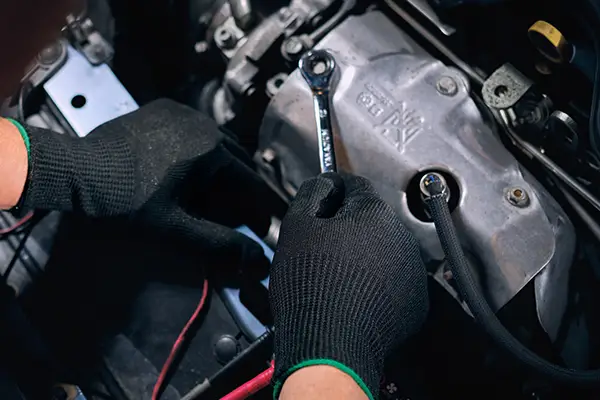
Nitrile-coated gloves are ideal for car repairs. They are oil-resistant, lightweight, and provide excellent grip, making them the best choice for mechanics.
Are Microfoam Work Gloves Really the Best for Comfort and Lightweight Use?
Microfoam work gloves are considered one of the best options for lightweight and comfortable hand protection. They offer superior breathability, excellent grip, and high dexterity—making them a go-to choice for tasks requiring precision and extended wear comfort.
I’ve been working in environments that demand both comfort and protection for years, and I’ve tried just about every type of work glove out there. Lately, I’ve been using microfoam gloves and I can honestly say—they’re a game changer. In this guide, I’ll walk you through everything I’ve discovered about them, from how they’re made to how they perform in real jobs.
How Are Microfoam Gloves Made to Be Lightweight?
Microfoam gloves are made with a thin, breathable nitrile or polyurethane coating over a flexible knitted fabric. This design keeps them lightweight while maintaining durability and grip—ideal for comfort-focused work environments.
What surprised me most about microfoam gloves was how light they feel. They’re crafted using a breathable nitrile or polyurethane coating layered over a flexible knitted fabric like nylon or polyester. This makes them incredibly light but still durable enough for most tasks I encounter daily.
The microfoam texture has tiny air pockets that not only allow my hands to breathe but also give me excellent grip—even when I’m working with slippery or oily surfaces.

Why Are Microfoam Gloves Ideal for Precision Tasks?
Microfoam gloves are perfect for precision tasks because they offer excellent dexterity, a snug fit, and strong grip in both dry and wet environments—making them ideal for electronics, assembly, and detailed manufacturing work.
When I’m doing detailed tasks—like assembling tiny parts or working on electronics—I need gloves that don’t get in the way. That’s where microfoam gloves truly shine. Their snug fit gives me full control, and I can still feel the materials I’m working with.
Key Benefits:
- Fine Motor Control: I can easily handle small parts without losing touch sensitivity.
- Excellent Grip: Whether it’s wet or dry, these gloves hold up.
- Breathability: My hands stay cooler and less sweaty during long hours.
Durability vs. Comfort: What’s the Trade-Off?
Microfoam gloves offer a strong balance between comfort and durability. While lightweight and breathable, they still resist abrasions and minor cuts—ideal for medium-duty work but not heavy-duty applications.
One thing I’ve noticed is how well these gloves balance comfort and toughness. They hold up well against abrasion and small cuts—definitely good for most medium-duty tasks I face daily. But if I’m dealing with sharp edges or high-heat equipment, I’ll switch to something like leather gloves.
| Task Type | Microfoam Gloves | Leather Gloves | Rubber Gloves |
|---|---|---|---|
| Handling Small Parts | Excellent | Good | Poor |
| Abrasion Resistance | Good | Excellent | Good |
| Cut Resistance | Moderate | Excellent | Moderate |
| Heat Resistance | Low | High | High |
| Grip on Wet Surfaces | Excellent | Moderate | Good |
How Do Microfoam Gloves Compare to Other Lightweight Gloves?
Compared to latex or polyurethane gloves, microfoam gloves provide better breathability, more consistent grip, and greater overall comfort—making them the preferred choice for long work hours.
I’ve also used latex and polyurethane gloves, and while they’re okay, they just don’t offer the same breathability and comfort. Latex tends to trap heat and moisture, and polyurethane doesn’t give me the same grip. Microfoam gloves strike the right balance.
| Feature | Microfoam Gloves | Rubber Gloves | Latex Gloves |
|---|---|---|---|
| Weight | Lightweight | Heavier | Light to medium |
| Breathability | High | Low | Medium |
| Dexterity | Excellent | Fair | Good |
| Protection | Moderate to High | High | Low to Moderate |
| Grip (Wet & Dry) | Excellent | Moderate | Moderate |
Microfoam Gloves in Different Industries
Microfoam gloves are used across industries like automotive, construction, food processing, and electronics—thanks to their superior comfort, grip, and flexibility.
From what I’ve seen on different job sites and factory floors, microfoam gloves are used just about everywhere. Here’s how they’re commonly applied across industries:
| Industry | Ideal Use Case | Key Benefit |
|---|---|---|
| Automotive & Manufacturing | Handling small parts, tools, machinery | Grip and precision |
| Construction | Light construction, general assembly | Comfort and durability |
| Food Processing | Food handling, preparation | Breathability and hygiene |
| Electronics Assembly | Assembly of small components | Dexterity and tactile sensitivity |
FAQs About Microfoam Gloves
Here are quick answers to common questions about microfoam gloves, including their cut resistance, washability, food safety, and wet-environment performance.
Q1: Are microfoam gloves cut-resistant?
Yes, they’re moderately cut-resistant—perfect for light to medium-duty tasks. But for heavy cutting, I use specialized gloves.
Q2: Can microfoam gloves be used in wet environments?
Absolutely. I’ve found their grip to be reliable even with oil or water.
Q3: Are microfoam gloves washable?
Yes, I wash mine on a gentle cycle, and they’ve held up nicely over time.
Q4: Are microfoam gloves food-safe?
Some are. I always check the product specifications to make sure they meet food safety standards.
User Feedback on Microfoam Gloves
Workers praise microfoam gloves for reducing hand fatigue and enhancing grip—especially in manufacturing and assembly tasks requiring long hours of precision handling.
Everyone I’ve spoken to who’s used microfoam gloves says the same thing—they’re comfortable, breathable, and reliable. I’ve personally noticed less hand fatigue and better control during long shifts.
"These are by far the most comfortable gloves I’ve used in my 10 years of factory work." — John D., Quality Inspector
Conclusion
Microfoam gloves are a top choice for lightweight, breathable, and flexible hand protection. Ideal for precise tasks, they offer long-lasting comfort and performance across multiple industries.
So, after all the testing and real-world use, I can confidently say microfoam gloves are worth it. They offer the comfort, grip, and flexibility I need—without sacrificing protection. If your job involves precision and long hours, you’ll probably appreciate them as much as I do.
Want to try them out for yourself? Check out the full range of microfoam gloves [here].



